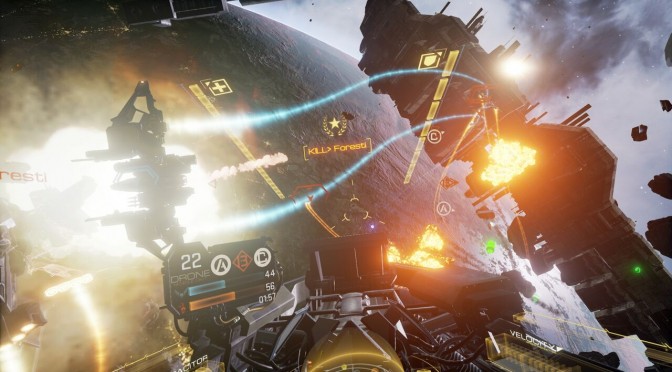CCP Games has released a new update for EVE: Valkyrie that introduces a new Ultra graphics mode. CCP Games has been working with NVIDIA in order to improve the game’s visuals and this new Ultra setting is powered by NVIDIA’s VRWorks and GameWorks techniques.
This new Ultra mode adds God rays to the maps, improves cockpit lighting, increases the quality of lighting and shadowing in every area and level, improves the fidelity of reflections and shaders, and adds dynamic lights – as well as more visual effects – to projectiles.
As NVIDIA’s press release reads:
“A lighting model developed by NVIDIA and incorporated by CCP for EVE: Valkyrie uses high-quality, physically-based lighting effects from NVIDIA Volumetric Lighting to add immersive, awe-inspiring shafts of bright light (God rays) to many scenes and levels, transforming their appearance. EVE: Valkyrie also includes a new anti-aliasing technique developed by NVIDIA called Multi-Sample G-Buffer Anti-Aliasing which improves anti-aliasing by further reducing visible aliasing of geometry edges and specular highlights, giving players a superior visual experience.”
CCP Games suggested that this Ultra mode is for PC players with higher spec Nvidia cards, such as the GTX1070, GTX1080 and the GTX1080Ti. However, the team did not clarify whether this new graphics mode is available exclusively to NVIDIA’s GPUs or not.
It’s also worth noting that EVE: Valkyrie is also using NVIDIA’s Lens Matched Shading rendering technique to improve performance and quality.
This update is already available and will be auto-downloaded from Steam.

John is the founder and Editor in Chief at DSOGaming. He is a PC gaming fan and highly supports the modding and indie communities. Before creating DSOGaming, John worked on numerous gaming websites. While he is a die-hard PC gamer, his gaming roots can be found on consoles. John loved – and still does – the 16-bit consoles, and considers SNES to be one of the best consoles. Still, the PC platform won him over consoles. That was mainly due to 3DFX and its iconic dedicated 3D accelerator graphics card, Voodoo 2. John has also written a higher degree thesis on the “The Evolution of PC graphics cards.”
Contact: Email

